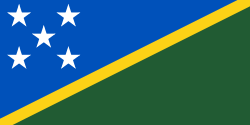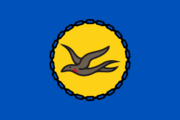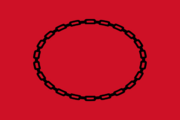Flag of Solomon Islands facts for kids

Flag of Solomon Islands
|
|
| Use | National flag |
|---|---|
| Proportion | 1:2 |
| Adopted | 18 November 1977 |
| Design | A thin, yellow stripe dividing diagonally from the lower hoist-side corner to the upper fly-side corner: the upper triangle is blue with five white five-pointed stars arranged in an X pattern and the lower triangle is green |
The flag of the Solomon Islands is a colorful symbol of the country. It has a bright yellow stripe that goes diagonally from the bottom left to the top right. This stripe divides the flag into two triangles: a blue one at the top and a green one at the bottom. In the blue section, there are five white stars.
This flag was chosen in 1977. It replaced an older flag that showed the British Blue Ensign. The new flag became the official symbol of the Solomon Islands on November 18, 1977. This was eight months before the country became fully independent. Even though the number of provinces in the Solomon Islands has grown, the number of stars on the flag has stayed the same.
Contents
History of the Solomon Islands Flag
Early Flags Under British Rule
For a long time, the Solomon Islands were under British control. This period was called a protectorate. In 1893, the British took charge of the southern part of the islands. Later, in the early 1900s, Germany gave its northern part of the islands to the United Kingdom.
During this time, the islands used the Union Jack, which is the flag of the United Kingdom. They also used a special version of the British Blue Ensign. This flag had the protectorate's name and the king or queen's crown on it.
In 1947, a new symbol was added to the flag. It was a red shield with a black and white sea turtle. But this design was changed just nine years later. The turtle symbol was only important to one part of the islands, not all of them. So, in 1956, a new design appeared. It showed a lion, an eagle, a turtle, a frigate bird, and local weapons.
Designing a New Flag for Independence
As the Solomon Islands prepared to become an independent country, a competition was held in 1975. People were asked to design a new flag. One idea included the country's coat of arms.
The first design that won had a blue background with a yellow circle. Inside the circle was a black frigate bird. However, this design was also rejected. Like the turtle, the frigate bird was only important to one province.
Another winning design had a red background with a black oval chain in the middle. The artist said this chain represented the history of blackbirding in the country. This was a sad time when people were taken from their homes to work. This design caused a lot of discussion and was also not chosen.
Finally, the design that we see today was created by a teacher from New Zealand. This teacher taught visual arts at a school in Honiara, the capital city. The stars on the flag stand for the different provinces of the country. They do not represent the Southern Cross, which is seen on the flags of nearby countries like Australia and New Zealand. The new flag was officially adopted on November 18, 1977. This was just before the Solomon Islands became the last British protectorate to gain independence.
After Independence
The official Independence Day ceremony happened on July 7, 1978. It took place in Gizo. During this event, the British Union Jack flag was lowered, and the new Solomon Islands flag was raised.
Since 2012, the Solomon Islands flag has also been used as a flag of convenience. This means that ships from other countries can fly the Solomon Islands flag. The government hoped this would bring in more money through taxes. It also aimed to create new job opportunities for local sailors.
Understanding the Flag's Design
What the Symbols Mean
Every part of the Solomon Islands flag has a special meaning.
- The blue color represents the water. This includes the rivers, rain, and the huge Pacific Ocean that surrounds the islands.
- The green color stands for the land. It reminds us of the many trees, forests, and crops that grow on the islands.
- The yellow stripe symbolizes the sun. It looks like a ray of sunshine dividing the land and the ocean.
The five white stars are arranged in an 'X' shape in the blue section. These stars were originally meant to show the provinces that the country had when it became independent. Even though more provinces have been created since then, the number of stars on the flag has stayed the same.
Similar Flag Designs
There have been ideas for new flags for Australia. One of these ideas is called the 'Southern Horizon'. This design has blue, gold, and green colors. It also shows the Southern Cross stars. Many people have noticed that this proposed Australian flag looks a lot like the flag of the Solomon Islands.
Different Versions of the Flag
The Solomon Islands has a few different versions of its flag for specific uses:
- The civil ensign is a red flag used by merchant ships (ships that carry goods). It has the national flag in the top left corner.
- The state ensign is a blue flag used by non-military government ships. It also has the national flag in the top left corner.
- The naval ensign is used by police vessels. It is based on the British White Ensign, which is a red cross on a white background. This flag also has the national flag in its top left corner.
| Variant flag | Usage |
|---|---|
 |
Civil ensign |
 |
State ensign |
 |
Customs Service Ensign |
 |
Naval Ensign |
Historical Flags of the Solomon Islands
| Historical flag | Duration | Description |
|---|---|---|
 |
1893– 1906 | The Union Jack, the flag of the United Kingdom. |
 |
1906–1947 | A British Blue Ensign with the protectorate's name and the Tudor Crown. |
 |
1947–1956 | A British Blue Ensign with a shield showing a black and white sea turtle. |
 |
1956–1966 | A British Blue Ensign with a shield showing a lion, an eagle, a turtle, a frigate bird, and local weapons, all on a white circle. |
 |
1966–1977 | The same as the previous flag, but without the white circle behind the shield. |
See also
 In Spanish: Bandera de las Islas Salomón para niños
In Spanish: Bandera de las Islas Salomón para niños





